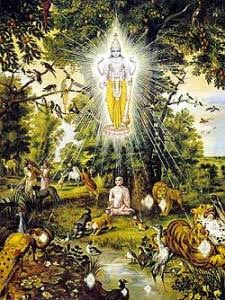There are three aspects of God:
1 - Brahman, the Lord's impersonal feature.
2 - Paramatma, his all-pervading localized aspect.
3 - Bhagavan, his Supreme person hood.
The four primary attributes or personal qualities of God are –
1 - Sat (being, or eternality),
2 - Chit (full cognition or Knowledge),
3 - Ananda (unending bliss)
4 - Vigraha "Bodily Form". The original perpetual "Spiritual bodily Form" of God, and the original "bodily form" of the living entities (jiva tattvas) without a beginning or end.
The Supreme Personality of Godhead and cause of all causes Lord Krishna, and the individual marginal living entities (jiva-tattva souls), ARE eternal persons with bodily form as their full potential.
Such bodily form is the highest understanding of the Absolute Truth and is eternal without beginning or end as Bhagavad Gita As It Is explains.
Bhagavan or Krishna realization represents the sum total of all of God's qualities. Thus Krishna, Bhagavan himself, has a distinct place in the stratification of divinity.
The following analogy is describing the three different realizations of the Absolute truth. This analogy below, will help one understand the three levels of God-realization more clearly.
Three simple villagers and their guide are at a railway station, waiting in great anticipation for the train to arrive.
The three have never seen a train before.
1 - As one of them notices a massive structure pulling in at a distance, he comments on the headlight:
"What is this?" he asks.
The guide responds: "That is the train."
Confident that he has seen the train, the first villager leaves, satisfied.
2 - When the train approaches the platform, one of the remaining villagers exclaims:
"Oh! This is a train!"
He has seen the series of cars pulling into the station – the "form" behind the headlights.
He is now also confident that he has seen all there is to see and leaves.
3 - The third man patiently remains behind and when the train comes into the station, he has the opportunity to meet the "persons" (vigraha) on the train, the conductor and to see the various other passengers on board.
The three villagers went back to their small village and began to tell everyone what they had seen .
Though it was an undeniable truth that each had seen the same train, their descriptions were diverse; their realizations were all different.
The third villager obviously had a more complete experience than the other two as he saw that ultimately behind all the qualities of the train existed individual "persons".
He was able to convince the others of this fact, for he perfectly described what his two comrades had seen, and a lot more.
Analogically, the big light represents the effulgent impersonal aspect of the Lord (Brahman).
This light with something more behind it conveys the idea of divine substance, a personality that pervades all existence (Paramatma).
And the third villager's vision represents the most complete aspect of God realization (Bhagavan as a person and AS a perpetual Form), wherein one meets the Supreme Personality of Godhead, Lord Sri Krishna (as a person with a perpetual bodily form), and develops a relationship with him.
In the Vaishnava view, the above are considered different aspects of the same Absolute Truth, and they are all valid.
One views these different aspects of God according to one's spiritual advancement.
Lord Krishna is the Supreme Personality of Godhead and cause of all causes, the origin of all Vishnu and Narayana forms, and the embodiment of truth, consciousness, and joy, is known as Govinda, or Krishna.
He is beginningless as a person in bodily form, the origin of everything, and the cause of all causes." (Brahma-samhita 5.1)
As explained, Krishna is Bhagavan, the Supreme Personality of Godhead.
The Srimad Bhagavatam declares:
"Krishna is God himself" (krishnas tu bhagavan svayam) – He is not merely a portion or manifestation of God, as are so many other divinities in India; He is the original Manifestor, the Complete Godhead, the eternal Person.
He displayed on earth his eternal lila, or spiritual activities, approximately 5,000 years ago.
Vaishnava tradition teaches that Krishna engages in these activities eternally but manifested them on this planet only at that time which is extremely very rare.
This is because Krishna only comes in His original form to this planet, "once" every 8 billion 640 million human years.
Several pastimes of Krishna reflect grandeur and even harshness, as when he rids the world of evil forces.
Despite this, Krishna's appearance underscores the superiority of love over power, sweetness over opulence.
While most concepts of God evoke awe and reverence, Krishna evokes intimacy and personal relationship.*









No comments:
Post a Comment
Note: Only a member of this blog may post a comment.